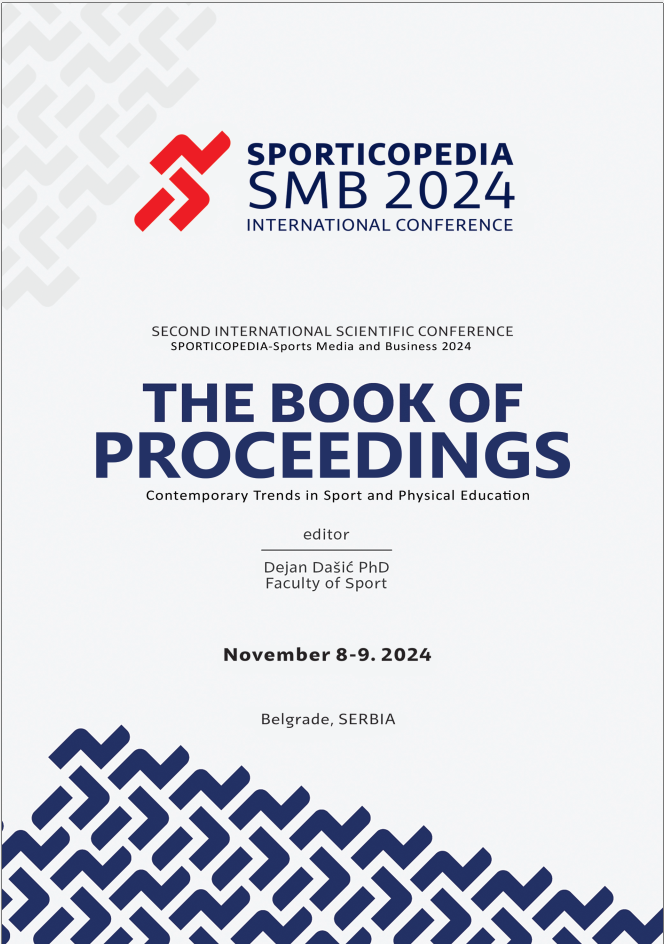Abstract
The selection process in sport includes the most diverse characteristics and dimensions for assessment and evaluation. Only by adequately combining genetic, physical, morphological-functional, psychological, pedagogical and sociological dimensions, the conditions necessary to define selection as a multidisciplinary science, which can provide prerequisites for achieving the set goals are gained. If we look at selection as a limiting factor that connects a certain sport with biological sciences on the one hand, and with the humanities on the other, creating a unique professional-scientific principle within such differentiated sciences, it carries enormous difficulties. That’s reason why theoretical and professional – research and practical work in selection is exposed to great risks, which require overcoming problems that constantly arise during work. Therefore, it is necessary to minimize all the demarcations that exist in different fields, while increasing the cohesiveness between the principles that operate within the framework of different scientific disciplines. The end result of this approach should be the synthesis of different knowledge and their transfer into one general, comprehensive framework. In this paper will be presented the methodological principles of selection in sports from the perspective of: models and model characteristics, tests as selection monitor instruments, prognosticate and evaluation of physical abilities testing results, growth and the process of maturing, psychosocial characteristics with special reference to genetic basis of physical abilities and morphological characteristics.
References
Abbott, A., Collins, D., Martindale, R. & Sowerby, K. (2002). Talent Identification and Development: An Academic Review. Edinburgh: Sportscotland.
Bjelica, D., Fratrić, F. (2011). Sportski trening – teorija, metodika i dijagnostika. Nikšić: Fakultet za sport i fizičko vaspitanje.
Bray, M.S., Hagberg, J.M., Pérusse, L., Rankinen, T., Roth, S.M., Wolfarth, B., Bouchard, C. (2009). The human gene map for performance and health-related tness phenotypes: the 2006-2007 update. Medicine and Science in Sports and Exercise,41(1), 35–73.
Brown, J. (2001). Sports talent. Champain: Human Kinetics.
Ericsson, K.A., Krampe, R.T., Tesch-Romer, C. (1993). The role of deliberate practice in the acquisition of expert performance. Psychol Rev, 100, 363–406.
Eynon, N., Ruiz, J. R., Oliveira, J., Duarte, J. A., Birk, R., Lucia, A. (2011). Genes and elite athletes: a roadmap for future research. The Journal of physiology, 13, 3063–3070.
Glisic, S., Radosevic, D., Perovic, V., Sumonja, N., Gemovic, B., Veljkovic, N., Dopsaj, M. (2016). Role of genetic markers in sport and recreational physical activity. Fizicka kultura, 70, 5–13.
Guth, L. M., Roth, S. M. (2013). Genetic influence on athletic performance. Current opinion in pediatrics, 25(6), 653–658.
Issurin, V.B. (2017). Evidence-based prerequisites and precursors of athletic talent: a review. Sports Med, 47(10), 1993–2010.
Ivanović, J. (2014). Modelne karakteristike indikatora eksplozivne sile opružača nogu kod vrhunskih sportista. Grafik centar: Beograd
Ivanović, J. (2020). Osnove upravljanja trenažnim procesom. Beograd: RIS STUDIOd.o.o.
Ivanović, J., Gajević, A. (2024). Selekcija u sportu. Beograd: Štamparija Glasnik.
Lidor, R., Côté, J., & Hackfort, D. (2009). ISSP position stand: To test or not to test? The use of physical skill tests in talent detection and in early phases of sport development. International Journal of Sport and Exercise Psychology, 7(2), 131-146.
Lloyd, R.S., Cronin, J.B., Faigenbaum, A.D., Haff, G.G., Howard, R., Kraemer, W.J., Micheli, L.J., Myer, G.D., Oliver, J.L. (2016). National Strength and Conditioning Association position statement on long-term athletic development. J Strength Cond Res, 30(6), 1491–1509.
Paranosić, V., Savić, S. (1977). Selekcija u sportu. Beograd: Partizan.
Ribeiro Junior D.B., Vianna J.M., Lauria, A.A., Coelho, E.F., Werneck, F.Z. (2019). Sports potential modeling of young basketball players: a preliminary analysis. Rev Bras Cineantropom Desempenho Hum, 21, e59832.
Ruiz, J.R., Gomez-Gallego, F., Santiago, C., Gonzalez-Freire, M., Verde, Z., Foster, C., Lucia, A. (2009). Is there an optimum endurance polygenic profile? J Physiol, 587, 1527–34.
Williams, A., Folland, J. (2008). Similarity of polygenic profiles limits the potential for elite human physical performance. The Journal of physiology, 586, 113.
Williams, A.G., Wackerhage, H. (2009). Genetic testing of athletes. Medicine and sport science, 54, 176–186.


